Slab foundations are a common type of foundation for homes and buildings. They consist of a concrete slab that sits directly on the ground and provides a stable base for the structure. However, one potential issue with slab foundations is the occurrence of slab leaks, which can cause damage to the foundation and the structure above it. In this article, we will discuss what slab leaks are, what causes them, and how to reroute plumbing lines in slab foundation to prevent them.
What Are Slab Leaks?
A slab leak is a plumbing issue that occurs when the pipes that run through the concrete slab of a foundation develop a leak. Since the pipes are located beneath the foundation, it can be difficult to detect the leak and repair it. Over time, a slab leak can cause damage to the foundation, leading to cracks, uneven floors, and other structural issues.
What Causes Slab Leaks?
Several factors can contribute to the development of slab leaks. One common cause is the age of the pipes. Over time, pipes can corrode or develop tiny cracks, which can eventually lead to leaks. Additionally, shifts in the soil beneath the foundation can put pressure on the pipes and cause them to break or leak. Other potential causes of slab leaks include poor installation, high water pressure, and water chemistry issues.
What Are the Signs of Slab Leaks?
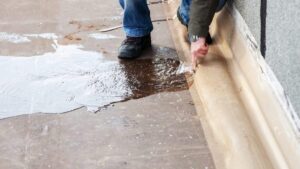
If you suspect that you have a slab leak, there are several signs to look for. One common indicator is a sudden increase in your water bill. Since slab leaks can waste a significant amount of water, you may notice a spike in your monthly bill even if your usage hasn’t changed. Other signs of a slab leak include damp or wet spots on your floors, low water pressure, and the sound of running water when no faucets are turned on.
Signs that rerouting plumbing lines is necessary.
If you have a slab leak, it’s important to address the issue as soon as possible to prevent further damage to your foundation and your home. In some cases, rerouting the plumbing lines may be the best solution. Here are some signs that rerouting may be necessary:
Multiple leaks: If you’ve had multiple slab leaks in the same area, it may be an indication that the pipes are old and need to be replaced.
Extensive damage: If your foundation has already sustained significant damage from a slab leak, rerouting may be necessary to prevent further damage.
Poor pipe placement: If the original plumbing installation was poorly planned, rerouting the pipes may be the best solution to prevent future leaks.
Rerouting Plumbing Options
If you’ve determined that rerouting your plumbing lines is necessary, there are several options to consider. Two primary options are traditional rerouting methods and newer technologies.
Traditional Rerouting Methods

Jackhammering:
This involves breaking through the concrete slab with a jackhammer to access the damaged pipes. The old pipes are then removed, new pipes are installed, and the slab is repaired.
Tunneling:
This method involves digging a trench beneath the foundation and running new pipes through it. Once the new pipes are installed, the trench is filled in, and the slab is repaired.
Direct access:
In some cases, it may be possible to access the pipes by cutting a hole in the slab. This method can be less disruptive than jackhammering but still requires significant repairs to the slab once the work is completed.
Rerouting through walls:
Depending on the location of the damaged pipes, it may be possible to reroute them through walls or other areas of the home. This method can be less disruptive to the slab but may require extensive modifications to the home’s plumbing system.
Newer Technologies for Rerouting
In recent years, several newer technologies have emerged that allow for less invasive and more cost-effective rerouting of plumbing lines.
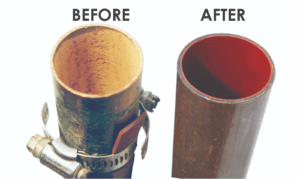
Epoxy pipe lining
This method involves coating the inside of the damaged pipe with a layer of epoxy, which seals any leaks and prevents future corrosion. It can be a less invasive and more cost-effective solution than traditional methods, but it may not be suitable for all types of pipes or leaks.
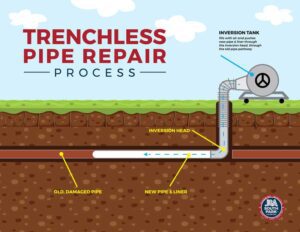
Trenchless pipe replacement
This method involves using a hydraulic machine to pull a new pipe through the existing damaged pipe, effectively replacing the old pipe without requiring excavation or significant damage to the slab. It can be a more cost-effective and less disruptive method than traditional rerouting, but it may not be suitable for all situations and types of pipes.
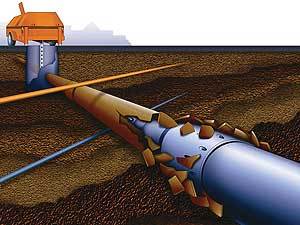
Pipe bursting
This method involves breaking apart the old pipe and replacing it with a new one. It requires less excavation than traditional rerouting but can be more expensive.

Cured-in-place pipe lining (CIPP)
This method involves inserting a flexible liner coated with resin into the damaged pipe, which hardens in place to create a new, leak-free pipe. It can be a less invasive and cost-effective solution for certain types of pipes and leaks but may not be suitable for all situations.
Benefits and Drawbacks of Traditional Methods and Newer Technologies
When deciding on a method for rerouting plumbing lines in a slab foundation, there are several factors to consider, including cost, disruption to the home, and effectiveness. Traditional methods such as jackhammering and tunneling are tried and tested, but they can be expensive and time-consuming. Additionally, they can be disruptive to the home’s interior and may require extensive repairs once the work is completed.
Newer technologies such as epoxy pipe lining and trenchless pipe replacement can offer a less invasive and more cost-effective solution, but they may not be suitable for all situations. For example, epoxy pipe lining may not be effective for certain types of leaks or pipes, and trenchless pipe replacement may not be feasible in areas with limited access or significant obstacles.
Ultimately, the best method for rerouting plumbing lines will depend on the specific needs of your home and the advice of a plumbing professional. By identifying the signs of slab leaks and addressing them promptly, you can prevent further damage to your foundation and ensure the long-term health and safety of your home.
Rerouting Preparation
Before you begin rerouting your plumbing lines, there are several preparation steps that you need to take. These steps will ensure that the process goes smoothly and that you are prepared for any potential challenges.
Preparation steps before rerouting:
First, you should consult with a licensed plumber to determine the best course of action for rerouting your plumbing lines. A professional plumber will be able to assess your situation and provide recommendations based on your specific needs.
Once you have determined the best course of action, you should obtain any necessary permits from your local government. This will ensure that your project is up to code and that you are legally permitted to perform the work.
Next, you should prepare the area where you will be rerouting the plumbing lines. This may involve removing any furniture or fixtures in the affected areas and covering the floors with protective materials.
Finally, you should create a plan for how you will reroute the plumbing lines, including any necessary measurements or calculations.
Safety Precautions
Rerouting plumbing lines can be a hazardous process, so it is essential to take appropriate safety precautions. Here are some critical safety precautions to follow when rerouting plumbing lines in a slab foundation:
- Always wear appropriate safety gear, including gloves, safety glasses, and a dust mask.
- Turn off the water and electricity supply before beginning work.
- Ensure that the work area is well-ventilated to prevent the buildup of harmful gases.
- Use appropriate tools and equipment to avoid injury, such as a saw or jackhammer.
- If you are unsure about any aspect of the process, consult with a professional plumber.
Tools and Equipment Required
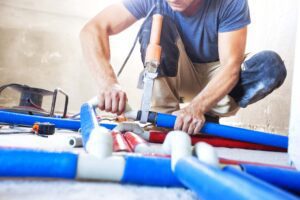
Rerouting plumbing lines in a slab foundation requires specialized tools and equipment. Here are some of the essential tools and equipment you will need:
- A saw or jackhammer to cut into the foundation and access the plumbing lines.
- Plumbing fittings, pipes, and connectors to create the new plumbing system.
- A drill to create holes in the foundation for the new plumbing lines.
- A pipe cutter or hacksaw to cut the new pipes to the correct length.
- A soldering iron or torch to connect the pipes and fittings.
Obtaining Permits
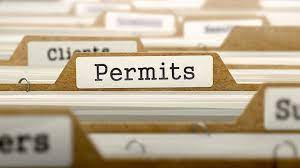
Before you begin rerouting your plumbing lines, it is essential to obtain any necessary permits from your local government. The permitting process ensures that your project is up to code and that you are legally permitted to perform the work. The exact permit requirements will vary depending on your location and the scope of the project. You should consult with your local government to determine the specific requirements for your project.
Accessing Plumbing Lines
Accessing plumbing lines in a slab foundation can be a challenging process. Here are some essential steps to follow when accessing plumbing lines in a slab foundation:
Identifying the Location of Plumbing Lines
Before you can access the plumbing lines, you need to identify their location. This may involve using a stud finder or other specialized tools to locate the pipes within the walls or foundation.
Cutting into the Slab Foundation
Once you have located the plumbing lines, you may need to cut into the slab foundation to access them. This may involve using a saw or jackhammer to create an opening in the foundation.
Accessing Plumbing Lines through the Walls
If the plumbing lines are located within the walls, you may need to remove a section of drywall or plaster to access them. This can be a delicate process, and it is essential to take care not to damage any other electrical or structural components within the wall.
Removing the Old Plumbing Lines
After you have accessed the plumbing lines, you will need to remove the old plumbing lines to make way for the new ones. This may involve cutting the pipes with a pipe cutter or hacksaw and removing any fittings or connectors.
Once the old plumbing lines have been removed, you can begin the process of installing the new plumbing system. This may involve drilling holes in the foundation for the new pipes, connecting the pipes and fittings using a soldering iron or torch, and testing the system for leaks.
Rerouting Plumbing Lines
Let’s take a closer look at what’s involved in rerouting plumbing lines in a slab foundation, including planning the new route, securing the new plumbing lines, connecting the new plumbing lines, sealing the connections, testing, and inspecting, and closing the access points.
Planning the New Route
The first step in rerouting plumbing lines in a slab foundation is to plan the new route. This involves determining the best location for the new plumbing lines based on the layout of your home and the location of the existing plumbing lines. You’ll need to take into account factors such as the location of existing fixtures, the type of plumbing materials used, and any potential obstacles such as electrical wires or other pipes.
Once you’ve determined the best location for the new plumbing lines, you’ll need to mark out the new route and make any necessary adjustments to the existing plumbing lines. This may involve cutting into the concrete slab, so it’s important to take the necessary safety precautions to prevent damage to your home and ensure the job is done safely and effectively.
Securing the New Plumbing Lines
Once the new route has been planned, the next step is to secure the new plumbing lines in place. This involves laying out the new pipes and connecting them to the existing plumbing system using fittings and connectors. It’s important to ensure that the new plumbing lines are properly aligned and level to prevent any potential leaks or damage to your home.
Connecting the New Plumbing Lines
After the new plumbing lines have been secured in place, the next step is to connect them to the existing plumbing system. This may involve cutting into the existing pipes and connecting them using fittings and connectors. It’s important to use the proper materials and techniques to ensure a secure and leak-free connection.
Sealing the Connections
Once the new plumbing lines have been connected to the existing plumbing system, the final step is to seal the connections. This involves applying sealant or epoxy to the joints and connections to prevent any potential leaks. It’s important to use a high-quality sealant that is designed for use with plumbing systems to ensure a strong and durable seal.
Testing and Inspection
After the new plumbing lines have been installed and connected, it’s important to test and inspect the system to ensure it is functioning properly and there are no leaks or other issues. This involves filling the system with water and pressurizing it to check for any leaks or other problems. It’s important to use the proper equipment and techniques to ensure an accurate and reliable test.
Checking for Leaks
Once the system has been tested, the next step is to check for any leaks. This involves visually inspecting the system for any signs of water or moisture, as well as using specialized tools such as a leak detection device to locate any potential leaks. It’s important to address any leaks or other issues as soon as possible to prevent damage to your home and ensure the system is functioning properly.
Final Inspection
After the system has been tested and any issues have been addressed, the final step is to perform a final inspection to ensure the job has been done correctly and to your satisfaction. This involves visually inspecting the system and checking for any signs of damage or other issues. It’s important to work with a qualified and experienced plumber who has the expertise and knowledge to perform a thorough and reliable inspection.
Closing the Access Points
Once the new plumbing lines have been installed and the system has been tested and inspected, the final step is to close the access points. This involves filling any access points with concrete or another appropriate material and repairing any damage to the slab foundation. It’s important to ensure that the access points are properly sealed to prevent any potential moisture or water intrusion.
Filling the Access Points
The first step in closing the access points is to fill them with concrete or another appropriate material. This involves pouring the material into the access points and allowing it to dry and cure. It’s important to ensure that the material is properly mixed and applied to ensure a strong and durable seal.
Repairing the Slab Foundation
Once the access points have been filled, the next step is to repair any damage to the slab foundation. This may involve patching or sealing any cracks or gaps in the concrete to prevent any potential moisture or water intrusion. It’s important to use the proper materials and techniques to ensure a strong and durable repair.
Reconnecting the Plumbing Fixtures
The final step in rerouting plumbing lines in a slab foundation is to reconnect the plumbing fixtures. This involves reinstalling the fixtures and connecting them to the new plumbing system. It’s important to ensure that the fixtures are properly aligned and securely connected to prevent any potential leaks or other issues.
Cost of Rerouting Plumbing Lines
If you’re planning on remodeling your home or making significant changes to your plumbing system, you may need to reroute your plumbing lines. Rerouting plumbing lines involves moving pipes and fixtures to a new location, which can be a complicated process that requires a professional plumber. As a homeowner, you may be wondering how much-rerouting plumbing lines will cost you.
The cost of rerouting plumbing lines can vary depending on a variety of factors, such as the size of your home, the complexity of the job, and the materials needed. In general, you can expect to pay anywhere from $1,000 to $5,000 for a rerouting plumbing lines job.
Factors affecting the cost
Several factors can affect the cost of rerouting plumbing lines. Some of the most significant factors include:
Size of the home: Larger homes will require more plumbing lines to be rerouted, which can increase the overall cost of the job.
The complexity of the job: If the job is more complex, such as rerouting plumbing lines through a concrete slab or multiple floors, it will require more labor and time, and the cost will be higher.
Type of pipes: The cost of the job will depend on the type of pipes used. If you need to install new pipes, copper pipes are the most expensive, while PVC pipes are the cheapest.
Location: The location of your home can also affect the cost of the job. Labor and material costs can vary depending on the area where you live.
Cost breakdown
The cost breakdown for rerouting plumbing lines can vary depending on the factors mentioned above. However, here is a general cost breakdown for rerouting plumbing lines:
Labor: The labor cost can range from $45 to $150 per hour, depending on the plumber’s experience and location.
Materials: The cost of materials will depend on the type of pipes used. Copper pipes can cost $2 to $4 per linear foot, while PVC pipes can cost $0.50 to $1 per linear foot. PEX piping is typically less expensive than copper pipes, with a cost ranging from $0.50 to $2 per linear foot.
Permits: Depending on your location, you may need to obtain permits for the job, which can cost anywhere from $100 to $500.
Additional costs: Additional costs may include drywall repair, painting, or landscaping, which can add to the overall cost of the job.
Tips for reducing the cost
Rerouting plumbing lines can be expensive, but there are a few tips that can help reduce the cost:
Plan ahead: Plan the rerouting plumbing lines job well in advance and get multiple quotes from professional plumbers to compare prices.
Be flexible: If possible, be flexible with the location of your fixtures and pipes. Small changes can help reduce the cost of the job.
DIY: If you have experience in plumbing and DIY projects, you can do some of the work yourself to save money.
Use PEX piping: PEX piping is a cost-effective alternative to copper pipes and can help reduce the cost of the job.
Hiring a Professional Plumber
Importance of Hiring a Professional
Hiring a professional plumber is crucial when it comes to rerouting plumbing lines. Professional plumbers have the necessary experience, expertise, and equipment to get the job done correctly and efficiently. Attempting to do it yourself or hiring an unqualified person can result in costly mistakes and even potential safety hazards.
How to Choose a Plumbing Contractor
When choosing a plumbing contractor, it is important to do your research and select someone with a solid reputation and a proven track record. Look for plumbers who are licensed, insured, and have a good standing with their local Better Business Bureau. Additionally, consider reading online reviews and asking for referrals from friends and family.
Questions to Ask Before Hiring a Plumbing Contractor
Before hiring a plumbing contractor, there are a few important questions to ask to ensure that they are the right fit for your needs. Some examples of questions to ask include:
- Are you licensed and insured?
- Do you have experience with rerouting plumbing lines?
- Can you provide references or examples of similar projects you have completed?
- What are your pricing structure and estimated timeline for the project?
- What measures do you take to ensure safety during the project?
Maintaining the New Plumbing Lines
Importance of Maintenance
Once the new plumbing lines have been installed, it is important to maintain them to ensure their longevity and efficiency. Regular maintenance can prevent costly repairs down the road and can help identify potential issues before they become major problems.
Maintaining the New Plumbing Lines
Regular maintenance for new plumbing lines includes checking for leaks, testing water pressure, and ensuring proper drainage. Additionally, it is important to inspect pipes for signs of wear and tear, such as corrosion or cracks, and to address these issues promptly.
Preventive Measures
There are several preventive measures homeowners can take to maintain their new plumbing lines. One important step is to avoid flushing anything other than toilet paper down the toilet to prevent clogs. Additionally, using drain covers can prevent debris from entering the pipes and causing blockages. It is also important to avoid using harsh chemicals or drain cleaners, as they can damage pipes and create hazards for plumbing systems.
Common Problems and Solutions
Despite regular maintenance and preventive measures, plumbing problems can still occur. Common issues include leaky pipes, low water pressure, and clogs. If these problems arise, it is important to address them promptly to prevent further damage. Hiring a professional plumber can help identify the root cause of the problem and provide the necessary solutions, such as repairing or replacing damaged pipes or removing blockages.
Benefits of Rerouting Plumbing Lines
Improved Water Pressure
One of the primary benefits of rerouting plumbing lines is improved water pressure. Over time, the pipes in your home can become clogged with mineral deposits and other debris, reducing the flow of water through your plumbing system. Rerouting the plumbing lines can eliminate these blockages and restore optimal water pressure to your home.
Reduced Risk of Leaks
Another advantage of rerouting plumbing lines is a reduced risk of leaks. Old and damaged pipes are prone to leaking, which can cause significant water damage and even mold growth in your home. Rerouting plumbing lines can eliminate these leaks and ensure that your plumbing system is functioning correctly.
Lowered Water Bills
By rerouting your plumbing lines, you can also potentially lower your water bills. Old and damaged pipes can cause water to leak out, wasting valuable resources and driving up your monthly water bill. Rerouting the plumbing lines can reduce the amount of water wasted and lead to lower bills.
Increased Property Value
Finally, rerouting your plumbing lines can increase your property value. Potential homebuyers are often looking for homes with modern, efficient plumbing systems. By rerouting your plumbing lines, you can make your home more attractive to buyers and potentially increase its value.
Alternatives to Rerouting
Temporary Fixes for Damaged Plumbing Lines
While rerouting plumbing lines is often the best long-term solution, there are alternative options to consider. Temporary fixes, such as patching leaks or using drain cleaners, can provide a quick fix to damaged plumbing lines. However, these solutions are only temporary and will likely need to be repeated over time.
When to Consider Alternative Options
If your plumbing system is relatively new and functioning correctly, rerouting the plumbing lines may not be necessary. Additionally, if the damage to your plumbing lines is minimal, temporary fixes may be sufficient. It’s essential to consult with a professional plumber to determine the best course of action for your specific situation.
Pros and Cons of Alternative Options
The primary advantage of using temporary fixes is that they are often less expensive than rerouting plumbing lines. However, they are only a short-term solution and may lead to further damage down the line. Additionally, temporary fixes can be time-consuming and may not always work effectively.
Cost Comparison
The cost of rerouting plumbing lines can vary depending on the extent of the damage, the size of your home, and the type of plumbing system you have. However, in most cases, rerouting plumbing lines is a more expensive option than using temporary fixes. It’s essential to weigh the long-term benefits of rerouting plumbing lines against the short-term savings of temporary fixes before making a decision.
Insurance Coverage
Coverage for Plumbing Line Damage
If you are facing the need to reroute plumbing lines, one question that may come to mind is whether your homeowner’s insurance will cover the cost. In most cases, insurance will cover damage to the plumbing lines themselves, such as from a burst pipe or leak. However, it is important to check your policy to see what is specifically covered.
Coverage for Rerouting Plumbing Lines
Coverage for rerouting plumbing lines may be trickier to determine. In general, insurance policies do not cover the cost of rerouting plumbing lines if it is simply for convenience or cosmetic purposes. However, if the rerouting is necessary due to damage or a covered event, such as a natural disaster, your insurance may cover some or all of the cost. Again, it is important to carefully review your policy and speak with your insurance provider to determine what is covered.
How to File an Insurance Claim
If you do need to file an insurance claim for plumbing line damage or rerouting, the process can be overwhelming. The first step is to contact your insurance provider as soon as possible to report the damage and begin the claims process. Be sure to provide as much documentation and evidence as possible, such as photos and receipts for repairs or replacement. Your insurance provider will likely send out an adjuster to assess the damage and determine the appropriate coverage.
What to Expect from the Insurance Company
It is important to keep in mind that insurance companies are businesses and will be looking to minimize their costs. This means that they may dispute your claim or offer a lower settlement than you were hoping for. It is important to review your policy carefully and understand your rights as a policyholder. You may also want to consider working with a public adjuster or attorney to help negotiate with the insurance company on your behalf.
Environmental Impact
In addition to the financial cost, there is also an environmental impact to consider when it comes to rerouting plumbing lines. Here are some factors to keep in mind:
Environmental Impact of Rerouting Plumbing Lines
Rerouting plumbing lines can have a significant impact on the environment, particularly if the new route requires cutting through the soil, vegetation, or other natural areas. This can cause soil erosion, disruption of wildlife habitats, and other negative effects. It is important to consider these impacts when planning a rerouting project and to work with professionals who can help minimize the environmental impact.
Eco-Friendly Plumbing Options
One way to reduce the environmental impact of plumbing projects is to choose eco-friendly plumbing options. These can include things like low-flow toilets and showerheads, water-efficient appliances, and rainwater harvesting systems. By reducing your water consumption, you can help conserve this precious resource and reduce your environmental footprint.
Benefits of Eco-Friendly Plumbing Options
In addition to the environmental benefits, there are also financial benefits to choosing eco-friendly plumbing options. For example, water-efficient appliances can help you save money on your monthly water bills. Additionally, choosing eco-friendly options may qualify you for tax credits or other incentives.
Cost Comparison
While eco-friendly plumbing options can be more expensive upfront, it is important to consider the long-term savings and environmental benefits. In some cases, the cost difference may be minimal, particularly if you factor in the financial benefits of lower water bills and tax credits.
Conclusion
Rerouting plumbing lines is a complex process that can have both financial and environmental impacts. While it may be necessary for a variety of reasons, it is important to carefully consider the cost, benefits, and potential drawbacks of this type of project. By understanding your insurance coverage and working with professionals who can help minimize the impact on the environment, you can ensure that your rerouting project is a success.

